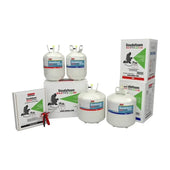The size and thickness of pipe insulation depend on various factors, such as the pipe's diameter, the surrounding temperature, the desired energy efficiency, and the type of insulation material. Here are some general guidelines:
- Pipe diameter: Measure the outer diameter of the pipe to ensure the insulation fits snugly around it. Insulation is typically available for common pipe sizes, such as 1/2", 3/4", 1", 1-1/4", and larger.
- Insulation thickness: The thickness of the insulation will depend on the specific application and the insulation material. Common thicknesses for pipe insulation include 1/2", 3/4", 1", and 1-1/2". Thicker insulation provides better thermal performance but is more expensive and takes up more space.
- Temperature range: Consider the temperature range the insulation will be exposed to, including both the pipe's internal temperature and the external ambient temperature. Some insulation materials perform better at specific temperature ranges, so choose accordingly.
- Insulation material: Different insulation materials offer different levels of thermal performance, moisture resistance, and durability. Common pipe insulation materials include fiberglass, mineral wool, polyethylene, and elastomeric foam.
For residential applications, such as hot water pipes, a thickness of 1/2" to 1" is commonly used. For commercial and industrial applications or where energy efficiency is a priority, you might require a thicker insulation.
To determine the most appropriate size and thickness for your specific application, consult the insulation manufacturer's guidelines, energy efficiency recommendations, and any relevant building codes or regulations in your area.




















































